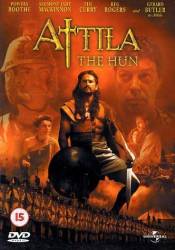Factual error: Aetius' troops don't look anything like 5th century Roman soldiers. They are carrying a large rectangular shield, a pilum (a spear which was used for throwing) and a sword (gladius) on their right. This was typical for the Roman army until about the 3rd century A.D. In Aetius' time, the soldiers would have had smaller oval shields, a hasta (a lance used for stabbing and for fending off cavalry attacks) and a sword (spatha) on their left. Also, there would be an enormous amount of "barbarian" mercenaries in the Roman army (Goths, Vandals, even Huns.), so it was hardly a Roman army anymore. And where's Aetius' cavalry?
Factual error: The Roman emperor Valentinian III did not kill Flavius Aetius after his victory over Attila. He killed the general one year after Attila's death, in 454 A.D.
Factual error: General Felix shouldn't have been in the movie at all because he was long dead in the time in which the movie is set. He was murdered in 430 A.D. on the orders of Aetius, many years before Attila became a threat.
Factual error: Theodosius II, the Byzantine (Eastern Roman Empire) emperor was not alive when Attila died. He died in 450 A.D.
Factual error: The clothes the Romans are wearing are not consistent with the time period. By the mid 5th century A.D., the Romans were beginning to wear dull and coarse clothing. The clothes the Romans are depicted wearing throughout the miniseries are typical of the early Empire (29 B.C. to 196 A.D.).
Factual error: Galla Placidia, the emperor Valentinian's mother, could never have witnessed her son murdering Flavius Aetius. Placidia died in 450 AD, Aetius four years later.
Factual error: Attila did not kill his brother Bleda in a duel, a day after his supposed coronation as King of the Huns, as depicted in the film. Nor did Attila become king after his brother's death. Historically, after the death of their uncle, King Rua, in 434 A.D., both Attila and Bleda shared the Hunnish throne until Attila killed his brother in 445 A.D.
Factual error: In the battle against the Visigoths, you can see that the soldiers carrying the standards of the Roman legion are positioned in the front lines. No Roman general would have put them there, because it would make them far too easy a target for enemy archers, skirmishers and infantry, especially since the standard bearers couldn't carry shields. Standard bearers (signiferes) were usually positioned behind the column of soldiers.
Factual error: Huns do not have brown hair and blue eyes as depicted in the film. They are a nomadic Asian people of Mongolian ancestry with dark hair and brown eyes.
Factual error: Attila was not poisoned by his new bride after his defeat in the Battle of Chalons in 451 A.D. He died naturally in 453 A.D after devastating Aquileia, Milan, Padua, and other cities in Italy.
Factual error: Several things are wrong in the scenes concerning the Battle of the Catalaunian Plains. What happens in the movie is this: Attila besieges and takes Orleans. Then he moves further south and Aetius retreats. Some time after that, Orestes tells Attila that 'Aetius has stopped retreating' and that the battle will take place near a place called Chalons. All wrong. What happened in reality was this: Attila never took Orleans and probably didn't even assault it. The Huns and their allies were moving way too slow, carrying all sorts of heavy siege equipment with them which bogged them down. When Aetius & the Romans and a large Visigothic army moved towards Orleans, Attila turned back. So it was he who was retreating, not Aetius. The battle never took place near Chalons. The Catalaunian Plains (near Troyes) are 50 miles to the south of Chalons (and not to the south of Orleans as Orestes has it).





